Why your political campaign should invest in public opinion research (a.k.a. polling)
Public opinion research has long helped candidates create their core messaging & strategy, but at a cost. Here’s a quick primer on the most common types of studies used by campaigns today.
You’ve probably somewhat familiar with the concept of political candidates referencing polls in news stories showing them X points ahead of their opponent.
That’s because public opinion research — a.k.a. polling, focus groups, and other data-focused marketing efforts — is a critical part of political campaigning that has long helped candidates develop their campaign strategies, create messages that resonate with the voting electorate, and identify supporters most likely to vote for them on Election Day.
Unfortunately, public opinion research is not cheap, so it is crucial to use it efficiently and as needed. That’s why campaigns will often use different types of public opinion research at different stages of the campaign.
But how do you determine which option(s) is right for your campaign now? Here’s a quick primer on the most popular types of public opinion research for political campaigns and their uses:
Polling: Public opinion studies — a.k.a. polling — is the most common type of public opinion research used by a political campaign. They typically involve surveying a representative sample of the population to gauge their opinions on a particular issue or candidate. While traditional public opinion polls were conducted via phone, most pollsters today use a multi-modal strategy for surveying voters — including phones, online responses, and, on occasion, in-person interviews. Among the different types of political polls that a campaign can commission are:
Benchmark or Messaging Studies: These polls measure public opinion on a particular issue or candidate. For example, a campaign might conduct a benchmark study at its onset to help identify the most important issues to voters in a particular district. The campaign could then use this information to develop its core strategy and messaging that are more likely to resonate with those voters.
Horse race or brushfire polls: These polls are typically shorter versions of the Benchmark/Messaging Study, and focus more on predicting the outcome of an election by asking largely head-to-head ballot questions. For example, if a horse race poll shows that a campaign is trailing, the campaign might need to adjust its strategy or increase its spending. They can also be used to help refine a message that was previously tested in the original Benchmark study.
Tracking polls: These polls measure public opinion over time. These polls are especially popular in the final weeks leading up to an election (primary or general) and measure daily changes in the race or vote for that district.
Focus groups: Focus groups are small groups of people who are brought together (either online or in-person) to discuss their opinions on a particular issue or candidate. Focus groups are a good way to get in-depth insights into the public's thinking or helping to create/test different strategies and messages for the campaign.
In-depth interviews: In-depth interviews can be conducted with individual voters to learn more about their opinions on a particular issue or candidate. Because these are expensive to conduct, they are often used sparingly for political campaigns and only when extensive information is needed on a series of subjects related to the campaign/candidate. In-depth interviews can be conducted in person, by phone, or online.
Social media analysis: Social media analysis can be used to track public sentiment on a particular issue or candidate by monitoring the social media posts, hashtags, and trends of voters within the district. This is a fairly new type of study but has grown in popularity as voters continue to partake in social media activities prior to Election Day.
Voter file analysis: Voter file analysis can be used to identify potential supporters within the district and to learn more about their demographic characteristics and voting history. This is often done in conjunction with another form of public opinion research, such as focus groups or traditional polling.
So what type of public opinion research should I use with my campaign?
The type of public opinion research that is best for a particular campaign will depend on the campaign's goals, budget, and resources. For example, a campaign with a limited budget may want to focus on using polling only, while a campaign with a larger budget may want to use a combination of studies.
Some additional thoughts to keep in mind as you consider implementing a public opinion research program:
Identify your goals. What do you want to learn from the public opinion research? Once you know your goals, you can choose the right type of research to meet your needs.
Choose the right firm. There are many different research firms out there — all of whom specialize in different types of research — so it’s important to choose one that not only has a good reputation but fits your needs and is within your budget.
Be aware of the limitations of public opinion research. Public opinion research is not a perfect science. There are always margins of error associated with public opinion data. It is important to keep these limitations in mind when interpreting the results of research.
ALWAYS use the research data to inform your campaign strategy. This is probably the most important tip of all. Make sure that you take the results of your studies and immediately implement them into every aspect of your campaign strategy — from communications to fundraising to grassroots. Allowing this data to inform your efforts will go a long way toward helping you achieve victory on Election Day.
By following these tips, political campaigns can use public opinion research effectively to inform their campaign strategies and to develop messages that resonate with voters.



